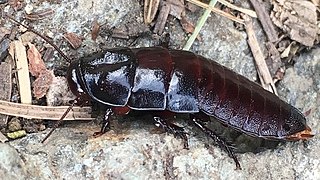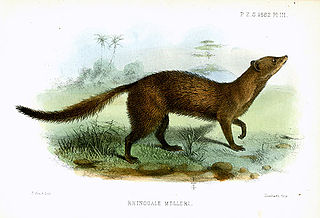
The aardvark is a medium-sized, burrowing, nocturnal mammal native to Africa. It is the only living species of the order Tubulidentata, although other prehistoric species and genera of Tubulidentata are known. Unlike most other insectivores, it has a long snout, similar to that of a pig, which is used to sniff out food.

Termites are a group of detritophagous eusocial insects which consume a wide variety of decaying plant material, generally in the form of wood, leaf litter, and soil humus. They are distinguished by their moniliform antennae and the soft-bodied and typically unpigmented worker caste for which they have been commonly termed "white ants"; however, they are not ants, to which they are distantly related. About 2,972 extant species are currently described, 2,105 of which are members of the family Termitidae.

The bat-eared fox is a species of fox found on the African savanna. It is the only extant species of the genus Otocyon and considered a basal canid species. Fossil records indicate this canid first appeared during the middle Pleistocene.

The Leptotyphlopidae are a family of snakes found in North America, South America, Africa and Asia. All are fossorial and adapted to burrowing, feeding on ants and termites. Two subfamilies are recognized.

Cryptocercus is a genus of Dictyoptera and the sole member of its own family Cryptocercidae. Species are known as wood roaches or brown-hooded cockroaches. These roaches are subsocial, their young requiring considerable parental interaction. They also share wood-digesting gut bacteria types with wood-eating termites, and are therefore seen as evidence of a close genetic relationship, that termites are essentially evolved from social cockroaches.

Paepalanthus bromelioides is a species in the flowering plant family Eriocaulaceae. This family is placed in the Poales, close to the Bromeliaceae, whose morphology this genus shares. Paepalanthus bromelioides is native to Cerrado. There is some speculation that the occasional insects trapped in the urn of this plant are evidence of its being a carnivorous plant or protocarnivorous, possible deriving nutrients from termite mounds that termites frequently make in the plants' roots.

Cockroaches are insects belonging to the order Blattaria. About 30 cockroach species out of 4,600 are associated with human habitats. Some species are well-known as pests.
Fibrobacterota is a small bacterial phylum which includes many of the major rumen bacteria, allowing for the degradation of plant-based cellulose in ruminant animals. Members of this phylum were categorized in other phyla. The genus Fibrobacter was removed from the genus Bacteroides in 1988.

The Myrmecophagidae are a family of anteaters, the name being derived from the Ancient Greek words for 'ant' and 'eat'. Two genera and three species are in the family, consisting of the giant anteater, and the tamanduas. The fossil Eurotamandua from the Messel Pit in Germany may be an early anteater, but its status is currently debated.

Tamandua is a genus of anteaters in the Myrmecophagidae family with two species: the southern tamandua and the northern tamandua. They live in forests and grasslands, are semiarboreal, and possess partially prehensile tails. They mainly eat ants and termites, but they occasionally eat bees, beetles, and insect larvae. In captivity, they will eat fruits and meat. They have no teeth and depend on their powerful gizzards to break down their food.

Meller's mongoose is a small brown mongoose native to savannas and woodlands of southeastern Africa. It is the only member of the genus Rhynchogale. The Meller's mongoose lives alone and is active at night, feeding on termites or other small insects and animals. While somewhat rare, it is adaptable and faces no serious threats. It is a member of the mongoose family (Herpestidae), a group of fox-like animals native to Asia, southern Europe, and Africa.
Ramphotyphlops is a genus of nonvenomous blind snakes of the family Typhlopidae. Member species of the genus are native to southern Asia and southeast Asia, as well as many islands in the southern Pacific Ocean. They occur in a wide variety of habitats. Currently, 22 species are recognized as being valid.

Trichonympha is a genus of single-celled, anaerobic parabasalids of the order Hypermastigia that is found exclusively in the hindgut of lower termites and wood roaches. Trichonympha’s bell shape and thousands of flagella make it an easily recognizable cell. The symbiosis between lower termites/wood roaches and Trichonympha is highly beneficial to both parties: Trichonympha helps its host digest cellulose and in return receives a constant supply of food and shelter. Trichonympha also has a variety of bacterial symbionts that are involved in sugar metabolism and nitrogen fixation.

Termitomyces, the termite mushrooms, is a genus of basidiomycete fungi belonging to the family Lyophyllaceae. All of which are completely dependent on fungus-growing termites, the Macrotermitinae, to survive, and vice versa. They are the food source for these termites, who enjoy an obligate symbiosis with the genus similar to that between Atta ants and Attamyces mushrooms. Termitomyces mushrooms are edible, and are highly regarded for their flavor.

Termitaphididae, occasionally called termite bugs, is a small tropicopolitan family of true bugs placed in the superfamily Aradoidea. Typically members of Termitaphididae are small, being an average of 2 millimetres (0.079 in)-4 millimetres (0.16 in), and flattened with laminae extending out from each body segment giving a round scale like appearance. Currently the family contains two genera and twelve known species. Members of Termitaphididae are inquilines lodging in the nests of host species of termite families Termitidae and Rhinotermitidae. Though considered a separate family in Aradoidea it has been suggested by Drs David Grimaldi and Michael Engel in 2008 that Termataphididae may in fact be highly derived members of Aradidae. Of the thirteen known species one Termitaphis circumvallata belongs to the monotypic genus Termitaphis and four of the remaining eleven species in Termitaradus are extinct, having only been found in amber. The living species are found worldwide in the tropical regions of Central and South America, Africa, Asia, and Australia.
The phylum Elusimicrobiota, previously known as "Termite Group 1", has been shown to be widespread in different ecosystems like marine environment, sewage sludge, contaminated sites and soils, and toxic wastes. The high abundance of Elusimicrobiota representatives is only seen for the lineage of symbionts found in termites and ants.

Termitotrox cupido is a species of scarab beetle in the subfamily Termitotroginae. It was first described by Munetoshi Maruyama in 2012, having been discovered living inside a nest of the termite Hypotermes makhamensis in Cambodia. It is a tiny, blind and flightless insect.

Zootermopsis laticeps, known generally as Arizona dampwood termite, is a species of termite in the family Archotermopsidae. Other common names include the wide-headed rottenwood termite and southwestern rottenwood termite. It is found in arid parts of south-western North America.

Macrotermes natalensis is a fungus-growing termite species that belongs to the genus Macrotermes. This species is associated with the Termitomyces fungal genus. M. natalensis has domesticated Termitomyces to produce food for the colony. Both termite species- fungal genus- are obligate and mutually beneficial where termite relies on the fungus to break down for plant materiel and nutrient resource. In contrast, the fungal species obtain plant material and optimal conditions for growth.

Reticulitermes tibialis, the arid-land subterranean termite, is a species of termite in the family Rhinotermitidae. It is found in the United States, mostly in the western half, occurring in deserts, prairies and other dry locations.
















